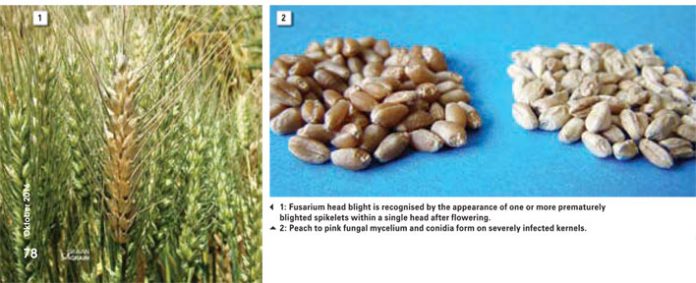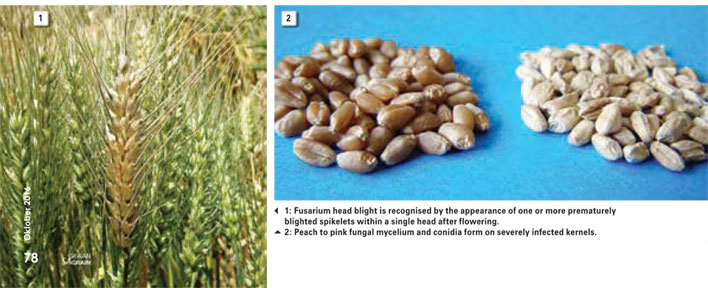October 2016
CATHY DE VILLIERS and SCOTT SYDENHAM, ARC-Small Grain Institute, Bethlehem
Wheat is one of the most important staple food crops in South Africa. Currently, wheat is produced in all nine provinces. The production areas of wheat depend on the soil type, soil depth, soil water content, the environment and the availability of irrigation in some environments.
The major limiting factors of wheat production in South Africa are diseases and pests, higher input costs, a lack of competitive edge compared to other crops, yield stability, quality and profitability for producers.
Fusarium head blight, also known as ear blight or scab, is one of the most important diseases occurring on wheat under irrigation. It increases yearly in incidence and severity worldwide, due to the use of susceptible cultivars and an increase in the adaptation of conservation agricultural practices.
Since the disease was initially recorded on wheat, barley and other small grains, 17 different Fusarium species have been associated with the disease worldwide. Fusarium graminearum is the species that predominates internationally (85%), followed by F. culmorum and F. avenaceum. Most Fusarium fungi are soil-inhabiting and may grow on living plant material as well as on dead organic material (as facultative saprophytes).
In South Africa, Fusarium head blight was observed for the first time in the 1980’s on irrigated wheat in the North West Province. Fusarium head blight is recognised by the appearance of one or more prematurely blighted spikelets within a single head after flowering (Photo 1).
The disease can spread throughout the ear (via the rachis), taking on a bleached straw colour, whereas healthy plants remain green. Peach to pink fungal mycelium and conidia form on severely infected kernels (Photo 2). Most infections result in reduced kernel number, kernel weight, and grain quality and spikelet sterility, and can cause yield losses of up to 70% under high infection. In contrast, infections that occur during the late stages of kernel development will have limited impact on yield.
In general, barley is more resistant to Fusarium, since the spikelets are enclosed in the flag leaf sheath during flowering, probably reducing the chances of infection. In some wheat cultivars, the retention of anthers during flowering and the presence of certain alleles of the dwarfing gene can significantly affect Fusarium head blight susceptibility.
Irrigation producers are encouraged to select their wheat varieties carefully. As shorter potentially higher-yielding varieties are closer to the ground, the higher risk of the optimal micro-climatic conditions being present around the ear during flowering for longer periods exists, making them more prone to Fusarium head blight susceptibility. Varieties with a good level of resistance are preferable.
Fusarium-infected grain may become contaminated with mycotoxins such as trichothecenes, moniliformin and fumonisins. The predominant mycotoxins are trichothecenes that are a group of secondary metabolites produced by different Fusarium fungal species.
In recent years, there has been a major focus on food safety around the world, which has concentrated on the trichothecenes and zearalenone (ZEA). These trichothecenes include deoxynivalenol (DON), 15-acetyldeoxynivalenol (15-DON), diacetoxyscirpenol (DAS), nivalenol (NIV), 4-acetylnivalenol (4-ANIV), 3-acetildeoxynivalenol (3-DON), and 4,15-diacetylnivalenol (4,15-Daniv).
Fusarium graminearum is a type B trichothecene producer, including DON, acetylated derivatives including 3-acetyl (3-ADON), 15-acetyl (15-ADON) and Nivalenol (NIV) chemo types. Zearalenone is always more abundant in maize than in wheat and barley.
Deoxynivalenol is more commonly known as vomitoxin, a name given by pig growers who associated vomiting with the consumption of contaminated maize kernels. Kernels are contaminated with toxins and are infected with the fungus. It was also called ‘the refusal factor’ because pigs refused maize containing this mycotoxin.
The trichothecene, NIV, produced by some isolates of Fusarium, is believed to be more toxic than DON and hence should be of more importance with respect to food safety. However, there is very little or no monitoring of NIV concentration levels present in grain.
Many studies have shown that mycotoxins can cause health problems such as mycoses when fed to farm animals such as pigs. Feed refusal, vomiting and hyperestrogenism are some of the symptoms exhibited by pigs.
Mycotoxins may also influence the reproductive performance in some livestock. Grain containing one or some of these mycotoxins, may be downgraded or rejected by the food and brewing industries, because of the health risks associated with mycotoxins.
Although barley is used as a staple food in some regions, it is also used for the production of malt and beer. When Fusarium-infected grain is used to produce beer, problems such as gushing of beer (uncontrolled foaming) are experienced. Mycotoxicosis symptoms in humans include nausea, diarrhoea, abdominal pain, dizziness, fever and in severe cases it may lead to throat- and mouth cancer if consumed regularly.
The analytical methods used for the detection of mycotoxins in infected grain include Enzyme-Linked Immunosorbent Assays (ELISA) and High Performance Liquid Chromatography (HPLC) tests. The HPLC method is currently much more sensitive and accurate in the determination of minute mycotoxin concentrations than the ELISA test, although it is much more expensive.
According to the European Union the limit of DON contamination in unprocessed cereals is set on 1,25 parts per million (ppm), whereas the limit for cereals intended for direct human consumption is set at 0,75 ppm. In South Africa there are currently no regulations regarding the measurement or limitation on the amount of DON present in cereals.
There are five types of resistance described in wheat. Type III resistance is described as resistance to the accumulation of DON in the infected grain that are currently being used in breeding and prebreeding programmes worldwide.
In South Africa, the ARC-Small Grain Institute (ARC-SGI), registered a Fusarium pre-breeding programme at the Winter Cereal Trust to combine imported Fusarium- and DON-resistant sources in the South African irrigation wheat cultivar spectrum.

The development of new sources of resistance will also provide breeders with greater choice of germplasm and may produce cultivars with Fusarium head blight- and DON-resistance in the future. In future if similar pre-breeding Fusarium head blight-resistance research is needed to service the barley, malting and brewing industries, the pre-breeding team at ARC-SGI will be in the best position to assist.
For more information, contact Cathy de Villiers or Dr Scott Sydenham at the ARC-SGI at 058 307 3400, DeVilliersC@arc.agric.za or SydenhamS@arc.agric.za.
Publication: October 2016
Section: On farm level



















